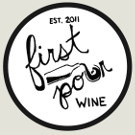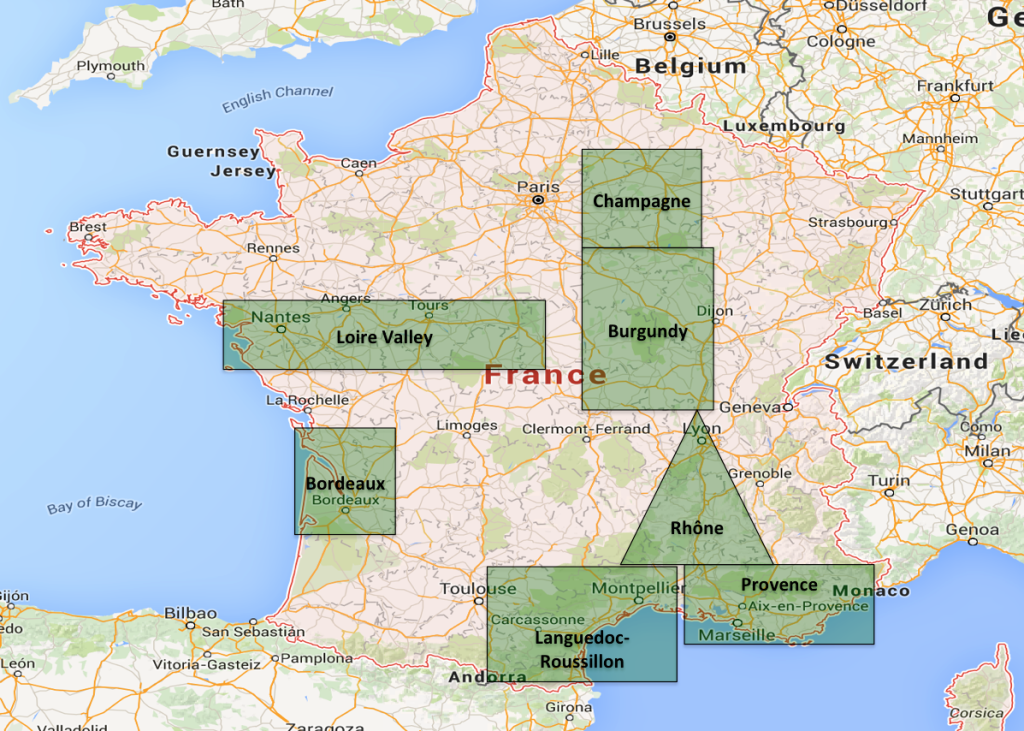One last note on France, a region that some may have noticed was conspicuously absent, Champagne.
Champagne
First and foremost, Champagne, by law, can only be made in Champagne.
Located north of Burgundy, and 90 miles northeast of Paris, Champagne is relatively cool, having an average temperature of only 50ºF. This puts Champagne right on the edge of where these vines are able to grow, in a region where the weather doesn’t always cooperate, with the frequent threat of rain ruining the crop. As if matters weren’t difficult enough, their unfortunate proximity to Germany has also meant the area has seen a few wars.
Ignoring the history it has endured, Champagne is much less complicated than say Burgundy, and is all contained in 1 AOC (think of a governed area that has very specific rules to try to help ensure quality). This helps to make Champagne less complicated, but despite this, it still has hundreds of thousands of vineyard plots. The villages these fall into are ranked by order of quality, with 17 being Grand Crus, 42 being Premier Crus, and some 250+ being Crus
The Grapes
To understand champagne, you must under that the region is perhaps one of the most self regulated in the world. To start with, only 3 grapes are allowed in Champagne, and each adds something unique:
- Chardonnay – Adds finesse, terroir, and laciness. It also is thought to be the primary driver in chalk or minerality in the sense of place Champagne has.
- Pinot Meunier – A clone of Pinot Noir, adds weigh to the body and fruitiness, the least capable of aging.
- Pinot Noir – Rich and complex, adds structure
Making Champagne
To make Champagne is something of a complicated process:
First – The grapes are hand harvested, and frequently, crushed right in the field. The lots are kept separate.
Second – The lots are fermented, almost exclusively in Stainless Steel (with a few exceptions that use very old and well used oak barrels).
Third – All of these individually fermented wines are still, and now ready to be blended. In addition to the base wines that are now available, even more reserve wines, which have been held back from previous years, are available, and must be used. (This is to ensure consistency from year to year)
Fourth – A few guys with really good memories, and even better tastebuds, that happen to be Champagne makers, get together and try to piece together a wine in the future, based on what they’re tasting right now, and from what they remember from the last time they did this and made some other wine that took years to see if they were correct about.
In other words, it’s like predicting the taste of the future using young wine and memories of the past.
Fifth (stay with me here, we’re halfway!) – Once they finalize the blend (the assemblage), they add a bit of yeast and a bit of wine mixed with sugar into each bottle of blend. This is then capped, and the yeast do their work!
Sixth – The bottles legally stay in the cellar, a minimum of 15 months. Usually, they age longer than that, causing the yeast to breakdown, and to add that creaminess that so vividly contrasts with the bright acidity.
Seventh – The bottles are riddled – Flipped upside down, and rotated many times (20+). The bottle is placed neck down in a rack, and the yeast collects in the neck.
Eighth – The yeast collected in the necks is frozen with glycol, the yeast plug is removed, and the wine is topped up with a mixture of reserve wine and sugar. The champagne is corked, and (theoretically) ready to drink.
At this point oxygen has been introduced, and the wine starts aging oxidatively (compared to reductively, before the yeast were removed). This entire process is called disgorging, and some premium champagnes will carry the date of disgorgement, so you can know how long since oxygen was introduced to the bottle.
Champagne Sweetness
Wondering how sweet that Champagne is? In the vast majority of cases, Champagne falls into the brut category, which is relatively dry. Still, other levels of sweetness exist, from dry to sweet, the order is:
- Brut Nature
- Extra Brut
- Brut
- Extra Dry
- Sec
- Demi-Sec
- Sweet
Vintages or Nonvintage Champage?
The biggest difference between Vintage and Nonvintage Champagne is the length of aging. Where nonvintage Champagne is required to age for 15 months, 3 years are required for vintage champagne. This typically means that in a vintage bottle, the quality of the grapes tends to be better (and from better vineyards), in order to survive the additional time aging on the lie. This generally means a more nuanced Champagne.

